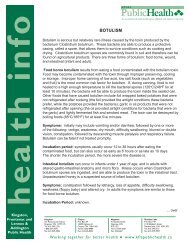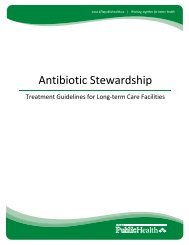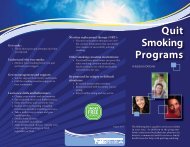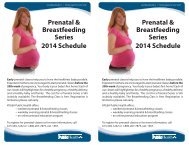Food Allergies and Anaphylaxis - KFL&A Public Health
Food Allergies and Anaphylaxis - KFL&A Public Health
Food Allergies and Anaphylaxis - KFL&A Public Health
Create successful ePaper yourself
Turn your PDF publications into a flip-book with our unique Google optimized e-Paper software.
<strong>Food</strong> <strong>Allergies</strong><br />
<strong>and</strong> <strong>Anaphylaxis</strong><br />
Adapted from material developed by <strong>Public</strong> <strong>Health</strong> Nutritionists/<br />
Dietitians in Ontario. May be reproduced without permission<br />
provided source is acknowledge. Distributed by: KFL&A <strong>Public</strong><br />
<strong>Health</strong>, 221 Portsmouth Avenue, Kingston, ON K7M 1V5,<br />
Tel: 613-549-1232 or 1-800-267-7875, Fax 613-549-7896,<br />
www.kflapublichealth.ca<br />
Reviewed May 2010
What is a food allergy?<br />
A food allergy is a response of the immune system to a<br />
component of food (a food “allergen”), usually a protein<br />
that the immune system recognizes as “foreign” to the<br />
body.<br />
The most common food allergens in<br />
Canada are: peanuts, tree nuts, fish<br />
(including shellfish), wheat, eggs, soy,<br />
milk, sesame seeds, <strong>and</strong> sulphites.<br />
What is anaphylaxis?<br />
<strong>Anaphylaxis</strong> is a severe allergic response to an allergen.<br />
It involves several body systems <strong>and</strong> can lead to death<br />
if untreated. <strong>Anaphylaxis</strong> may be caused by food, insect<br />
stings, latex, <strong>and</strong> medications.<br />
What about food intolerance?<br />
A food intolerance is not the same as a food allergy.<br />
<strong>Food</strong> intolerances can cause problems for people in<br />
ways that do not involve the immune system. Examples<br />
include lactose intolerance <strong>and</strong> gluten intolerance<br />
(celiac disease). Although not life-threatening, a food<br />
intolerance requires dietary modifications to avoid<br />
discomfort <strong>and</strong> risk for nutrient deficiencies.<br />
Signs <strong>and</strong> symptoms of an allergic reaction:<br />
itching <strong>and</strong> irritation of the skin (e.g. hives, rash),<br />
swelling of the throat, tongue, lips, or face,<br />
wheezing, coughing, shortness of breath,<br />
nausea, vomiting, abdominal cramps,<br />
drop in blood pressure, loss of consciousness,<br />
feelings of impending doom.<br />
Where can I find more information?<br />
<strong>Anaphylaxis</strong> Canada<br />
E-mail: info@anaphylaxis.ca<br />
Web: www.anaphylaxis.org<br />
A national, non-profit organization for people with life<br />
threatening allergies. Provides a wide variety of allergyrelated<br />
resources, as well as a newsletter <strong>and</strong> food-alert<br />
bulletins.<br />
Allergy/Asthma Information Association (AAIA)<br />
E-mail: admin@aaia.ca<br />
Web: www.aaia.ca<br />
A national non-profit organization for people affected<br />
by allergy, asthma, <strong>and</strong> anaphylaxis. Provides a variety<br />
of print <strong>and</strong> web resources, as well as a newsletter <strong>and</strong><br />
links to allergen-related activities across Canada.<br />
<strong>Food</strong> Allergy <strong>and</strong> <strong>Anaphylaxis</strong> Network (FAAN)<br />
E-mail: faan@foodallergy.org<br />
Web: www.foodallergy.org<br />
The largest food allergy association in the world. Offers<br />
a wide variety of print <strong>and</strong> web resources including<br />
books, brochures, recipes, <strong>and</strong> videos.
How can we prevent an allergic reaction?<br />
When eating out:<br />
Ask about the ingredients <strong>and</strong> the way food is<br />
prepared before you order. Even if the restaurant<br />
is part of a chain, ingredients may differ between<br />
locations.<br />
Restaurants bearing an Allergy Aware sticker will<br />
have a senior staff member on each shift who<br />
can answer your questions about ingredients.<br />
Order simply prepared foods such as baked<br />
potatoes, steamed vegetables, <strong>and</strong> broiled meat.<br />
They are less likely to have allergen-containing<br />
ingredients.<br />
Avoid buffets. There is a high risk for<br />
cross-contamination.<br />
Be especially cautious of the ingredients in ethnic<br />
foods, sauces, muffins, <strong>and</strong> desserts.<br />
If a staff member is unsure of the ingredient, or<br />
you are not 100% confident that a food is<br />
allergen-free, order something else.<br />
How do I h<strong>and</strong>le an allergic reaction?<br />
It is important to respond to an allergic reaction quickly.<br />
Be sure to talk with your child or teen about how to be<br />
prepared for a possible reaction. Make an emergency<br />
plan <strong>and</strong> share it with caregivers, friends, <strong>and</strong> other<br />
acquaintances.<br />
<strong>Food</strong> allergies can be life-threatening. A<br />
person with a milk allergy must avoid<br />
all milk protein—even the small amount<br />
found in a slice of bread. A person with<br />
lactose intolerance may be able to tolerate<br />
milk products such as cheese, yogurt, <strong>and</strong><br />
modified milk.<br />
Is there a cure for allergies?<br />
No. The only “treatment” for a food allergy is avoidance<br />
of all products containing the allergen.<br />
Will my child outgrow this allergy?<br />
Not likely. Young children with allergies to milk, eggs,<br />
wheat, or soy may outgrow a food allergy. <strong>Allergies</strong> to<br />
peanuts, tree nuts, fish, <strong>and</strong> shellfish are less likely to<br />
be outgrown. Talk to your doctor or allergist for more<br />
information. Never re-introduce an allergen-containing<br />
food without approval from your allergist.<br />
How can we prevent an allergic reaction?<br />
When away from home:<br />
Inform friends, relatives, <strong>and</strong> acquaintances<br />
about the food allergy.<br />
Carry prescribed medications <strong>and</strong> have an<br />
emergency plan available in case of a reaction.<br />
Know how to use an autoinjector if prescribed.
How can we prevent an allergic reaction?<br />
When Shopping:<br />
Read the ingredient list every time you shop.<br />
Ingredients often change without warning—a<br />
product that was safe last week may not be safe<br />
this week.<br />
Be aware of the words on the ingredient list that<br />
may indicate the presence of an allergen.<br />
Avoid foods with the disclaimer “may contain<br />
traces of allergen (e.g. peanuts).” There is no<br />
guarantee that these foods are safe for the<br />
food-allergic person.<br />
Avoid foods without a complete ingredient list,<br />
such as bulk foods or on-site bakery items.<br />
Choose less processed foods. Generally, the<br />
less processed a food, the easier it is to identify its<br />
ingredients.<br />
Avoid imported food with foreign language<br />
ingredient lists <strong>and</strong> those foods that do not follow<br />
the Canadian <strong>Food</strong> Inspection Agency guidelines.<br />
If you do not know what an ingredient word<br />
means, do not buy the food.<br />
Have a pad <strong>and</strong> pen with you when you shop. If<br />
you have a question about a product, record the<br />
manufacturer’s name, phone number, <strong>and</strong> address.<br />
Contact the manufacturer when you get home.<br />
State that you have a food allergy <strong>and</strong> ask whether<br />
the product contains a particular allergen.<br />
Most allergic reactions are due to cross<br />
contamination. “Safe” foods become “unsafe”<br />
through contact with allergen particles. For<br />
example, the same knife from the peanut<br />
butter jar is put into the jam jar. The jam is<br />
now unsafe for people with a peanut allergy.<br />
Or, the same cutting board is used the make<br />
both an egg-salad s<strong>and</strong>wich <strong>and</strong> a turkey<br />
s<strong>and</strong>wich without being washed in between.<br />
The turkey s<strong>and</strong>wich is now unsafe for people<br />
with an egg allergy.<br />
How can we prevent an allergic reaction?<br />
When preparing foods:<br />
Use soap <strong>and</strong> water to clean h<strong>and</strong>s before <strong>and</strong><br />
after eating. H<strong>and</strong> sanitizers are not suitable, as<br />
they may not rid traces of an allergen.<br />
Wash all utensils, counters, <strong>and</strong> eating surfaces<br />
with a household cleaner before <strong>and</strong> after food<br />
preparation. This will help to avoid “cross<br />
contamination.”

















